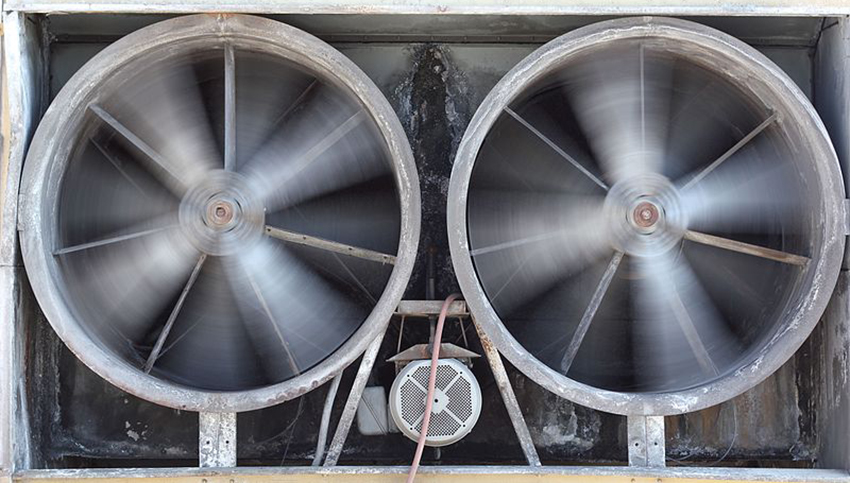Where’s My Air?

Air flow in an HVAC system is very important to achieving the primary goal, which is comfort within a space. Reducing the necessary quantity of air can create a lot of problems, and these problems happen frequently with today’s prepackaged equipment. The competitiveness in our industry pushes efficiency, thereby limiting the ability to have extra capacity in any fan selection. When you factor in the desires for less shipping weight and reducing costs, you will not be able to provide extra fan and motor capacity.
HVAC packages (such as rooftop units) have supply fans that are sized for an air flow volume based on a predetermined external static pressure. An example would be a 10-ton unit, 4000 CFM of air (400 CFM per ton) against .75” of external resistance. The .75” is anything that is remote from the unit and may include both return air and supply air ductwork, grilles and registers. The motor HP would be predetermined based on this external static pressure.
Larger central station air handlers or belt drive commercial units have an advantage, because the designer has the ability to select the fan (type and size) and its capacity (CFM versus static pressure) based on the project requirements thereby building in service factors to make sure air flow isn’t compromised. For example, a central station unit to provide 20,000 CFM of air at 2.00 external static pressure but can factor in a drive (fan, motor and drive components) that can handle up to 10% more capacity.
Direct drive fan coil units (ceiling, wall or floor) are always sized based on a given CFM versus a very low amount of external static pressure. Since the motor is directly connected to the fan, any modifications can drastically change the air flow.
Packaged units and condensing units that are “air cooled” can also have air flow problems on the condenser side, since they depend on direct connected motors to propeller fans. These are never sized for any external resistance.
Why is air flow less than required?
On supply fans in any type of HVAC unit, initial reduction of air flow is always based on too much external static pressure. If the goal is 400 CFM per ton and the external static pressure maximum is exceeded, the air flow may be reduced by 5% or 10%. This will in turn reduce the BTUH capacity of the unit and the air coverage within the space. Less air creates a lower air velocity; and therefore, a reduction of air throw into the space.
The external components must be designed to the maximum external static pressure. If not, you will immediately experience air volume problems.
During the life of your unit, fouled air side components can also drastically reduce air flow in any HVAC unit. The primary causes of increased static pressure are: 1) dampers, 2) filters and 3) coils.
Let’s examine each one separately:
- Recirculated, fresh or exhaust air dampers can have added static pressure characteristics due to improper opening and closing. Blades can stick producing as much as twice the static pressure rating for the damper.
- Filters that are dependent on periodic maintenance can load, and they can have twice the static pressure rating when clean. Every facility and every installation have a different need for the changing of filters. If you don’t keep up with this, not only do you have unfiltered air, but you have less of it.
- Over the long haul, coils can cause the biggest difference in design and actual static pressure. Coils become plugged when the upstream air is fouled. Over the years, these coils (especially multi-row cooling type) can have double or triple the static pressure as originally designed. Since the heat exchanger produces the heating or cooling BTUH, you can also have less heat exchange, which is a double whammy with the loading of these coils. Dirt and foreign material act as an insulator that reduces the exchange between what is running through the tubes and what is flowing across the fins.
- Condenser coil loading can be a very serious problem, because the fan is a propeller fan. Any fouling can cause condenser air flow to be reduced dramatically creating high head pressures that over time can create major component damage to include compressor failures. Remember: There is no protection of filtration on the entering air side, and coils can be upwards of 20 to 22 fins per inch. All installations do not have a clean environment, so there will be dirt and foreign material entering the condenser.
Southwest Coil represents USA Coil & Air exclusively in the Southwest Region. With 4+ decades of knowledge and experience, we are coil experts. We can assist you with clogged and dirty coil replacement. We have built thousands of designs, and many times can build with just a make and a model number. Important: We have expedited shipments for those projects where catastrophic problems need to be rectified ASAP.


